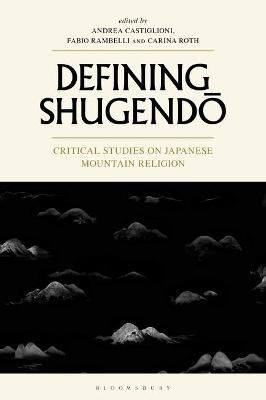
Defining Shugendo
Bloomsbury Academic (Verlag)
978-1-350-17939-4 (ISBN)
Defining Shugendo brings together leading international experts on Japanese mountain asceticism to discuss what has been an essential component of Japanese religions for more than a thousand years.
Contributors explore how mountains have been abodes of deities, a resting place for the dead, sources of natural bounty and calamities, places of religious activities, and a vast repository of symbols. The book shows that many peoples have chosen them as sites for ascetic practices, claiming the potential to attain supernatural powers there.
This book discusses the history of scholarship on Shugendo, the development process of mountain worship, and the religious and philosophical features of devotion at specific sacred mountains. Moreover, it reveals the rich material and visual culture associated with Shugendo, from statues and steles, to talismans and written oaths.
Fabio Rambelli is Professor of Japanese Religions and Cultural History and ISF Endowed Chair in Shinto Studies at the University of California, Santa Barbara, USA. Carina Roth is a Teaching and Research Fellow at the University of Geneva, Switzerland. Andrea Castiglioni is Senior lecturer in the Department of Humanities and Social Sciences, Nagoya City University, Japan.
1. Introduction
Part 1: Intellectual History of Shugendo Studies
2. A Critical History of the Study of Shugendo and Mountain Beliefs in Japan, Suzuki Masataka (Keio University, Japan)
Part 2: Constructed Topologies and Invented Chronologies
3. Shugendo within Japanese Buddhism, Hasegawa Kenji (Prefectural Museum of Tokushima, Japan)
4. Imagining an Ancient Tradition: Eighteenth-Century Narratives of Shugendo at Mount Togakushi, Caleb Carter (Kyushu University, Japan)
5. Otake Dainichi Nyorai and Haguro Shugendo: Unearthing a Lost History, Gaynor Sekimori (SOAS, University of London, UK)
6. Shugendo and Modernity Face to Face: The Daigoji Case, Hayashi Makoto (Aichi Gakuin University, Japan)
Part 3: Imagining the Founder, En no Gyoja, and Fictionalizing Shugendo
7. Between Companionship and Worship: A Reflection on En no Gyoja Statuary Past and Present, Carina Roth (University of Geneva, Switzerland)
8. En no Gyoja’s Legitimization in the Context of Japanese Esoteric Buddhism, Kawasaki Tsuyoshi (Shujitsu University, Japan
9. The Description of Mountains in Minoodera engi, Niki Natsumi (National Institute of Technology, Akashi College, Japan)
10. Images of the Shugenja in Edo Popular Fiction, William Fleming (University of California, Santa Barbara, USA)
Part 4: Materiality and Visual Culture of Shugendo
11. The Cult and Statuary of Zao Gongen, Fujioka Yutaka (Osaka University, Japan)
12. Religious Culture in Transition: Mt. Fuji, Janine Sawada (Brown University, USA)
13. The Shape of Devotion: Mounds, Stelae, and Empowering Ritual Fasting, Andrea Castiglioni (Nagoya City University, Japan
14. Shugendo as Social Practice: Kumano Talismans and Inscribed Oaths in Premodern Japan, (Max Moerman (Barnard College, USA)
Bibliography
Index
| Erscheinungsdatum | 13.11.2020 |
|---|---|
| Zusatzinfo | 24 bw illus |
| Verlagsort | London |
| Sprache | englisch |
| Maße | 156 x 234 mm |
| Gewicht | 599 g |
| Themenwelt | Geisteswissenschaften ► Geschichte ► Regional- / Ländergeschichte |
| Geisteswissenschaften ► Religion / Theologie ► Weitere Religionen | |
| ISBN-10 | 1-350-17939-6 / 1350179396 |
| ISBN-13 | 978-1-350-17939-4 / 9781350179394 |
| Zustand | Neuware |
| Haben Sie eine Frage zum Produkt? |
aus dem Bereich


